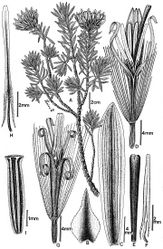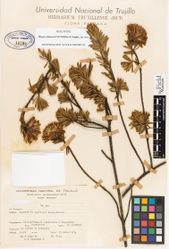Plazia robinsonii
| Notice: | This page is derived from the original publication listed below, whose author(s) should always be credited. Further contributors may edit and improve the content of this page and, consequently, need to be credited as well (see page history). Any assessment of factual correctness requires a careful review of the original article as well as of subsequent contributions.
If you are uncertain whether your planned contribution is correct or not, we suggest that you use the associated discussion page instead of editing the page directly. This page should be cited as follows (rationale):
Citation formats to copy and paste
BibTeX: @article{Dillon2014PhytoKeys34, RIS/ Endnote: TY - JOUR Wikipedia/ Citizendium: <ref name="Dillon2014PhytoKeys34">{{Citation See also the citation download page at the journal. |
Ordo: Asterales
Familia: Asteraceae
Genus: Plazia
Name
Plazia robinsonii M.O. Dillon & Sagást. sp. nov. – Wikispecies link – IPNI link – Pensoft Profile
Type
PERU. La Libertad: Prov. Huamachuco, Pallar – Huaguil, carretera a Tayabamba, 3000 m, 23 Jun 1974, A. López M. & A. Sagástegui A. 8123 (holotype: HUT12930!, isotypes: F1863606!, US3266111!).
Diagnosis
Plaziae confertae affinis, a qua foliis minoribus, capitulis majoribus et radiis 15–20 differt.
Description
Shrubs to 1 m, the branches erect; stems lacking spines. Leaves simple, sessile, in whorls at branch tips; blades oblanceolate, 10–25 mm long, 1–3 mm wide, uninerved, adaxial and abaxial surfaces glabrous; margins entire. Capitulescences of solitary, terminal heads, sessile. Capitula heterogamous, radiate; involucres broadly campanulate, c. 25 mm wide, 30 mm in diameter; receptacles plane, glabrous; phyllaries 4–5-seriate, the outer ovate, 8–12 mm long, 4–6 mm wide, apically acuminate, the inner oblong 20–25 mm long, 4–5 mm wide, apically acute, ciliolate; ray florets 15–20, the corollas ligulate-bilabiate, whitish, the tube 4–5 mm long, the outer lip 4-nerved, 8–12 mm long, tridentate, the inner lip bifid; styles cylindric, glabrous, bifid, the branches short, inconspicuous; disc florets whitish, c. 40, the corollas tubular, actinomorphic, glabrous, the limb deeply 5-lobed, the lobes 5–8 mm long, c. 1/2 the length of the corolla, coiled; anthers linear, the terminal appendages lanceolate, fused into a column, truncate, the bases caudate; styles claviform, the branches short, rounded. Achenes [ray and disc] glabrous, 5-ribbed, 4–5 mm long; pappus of scabrid bristles, c. 15 mm long, isomorphic, pale yellow.
Distribution and conservation
Known only from the type locality in an inter-Andean valley at around 3000 m (7°47.22'S, 77°52.27'W). The entire area surrounding Huamachuco and the road east to Tayabamba has been intensely cultivated for many years and is now highly disturbed by human pressure with expanding cultivation. Only fragmented small pockets of original habitats remain, usually in steeper quebradas. This species has not been recollected for 40 years and should be considered “critically endangered” (IUCN 2001[1]).
Discussion
The duplicates of the type collection of this new species were originally distributed under the generic name Diplostephium Kunth (1818)[2], a member of the tribe Astereae. The overall morphology of the material does superficially resemble some members of Diplostephium, however, the bilabiate corollas, truncate style branches, and anther tails are typical for the Mutisieae not the Astereae. The new species was uncovered after the Flora of Peru treatment (Ferreyra 1995[3]) was published and set aside for investigation. Only recently was the material encountered during routine filing, having been misplaced for nearly two decades.
The type locality is approximately 450 km north of its nearest congener, Plazia conferta, from near Tarma. Although the region where the original collections were made has been visited by numerous botanists, to our knowledge this species has not been recollected since 1974 when it was encountered by Abundio Sagástegui Alva and Arnaldo López Miranda. Casual efforts to find the plant again have not met with success. Given that the plant is quite showy and distinctive, it should not go undetected for long if it is indeed extant.
Etymology
This species honors Dr Harold Robinson, Senior Research Curator at the National Herbarium, Smithsonian Institution. He suggested with his annotation of the US sheet, designated as an isotype, that this taxon was perhaps a new species of Plazia, and not an unusual Diplostephium, as had been suggested on the original label.
Original Description
- Dillon, M; Luebert, F; 2014: Synopsis of Plazia Ruiz & Pav. (Onoserideae, Asteraceae), including a new species from northern Peru PhytoKeys, 34: 1-13. doi
Other References
- ↑ IUCN S (2001) IUCN Red List Categories and Criteria: Version 3.1. IUCN, Gland, Switzerland and Cambridge, United Kingdom, 1–30.
- ↑ Kunth K (1818) Diplostephium. Nova Genera et Species Plantarum (folio ed) 4: 75, t. 335.
- ↑ Ferreyra R (1995) Family Asteraceae: Part VI, Tribe Mutiseae. In: Macbride J. Flora of Peru. Fieldiana Botany. N.S. 35: 1-101.
Images
|

